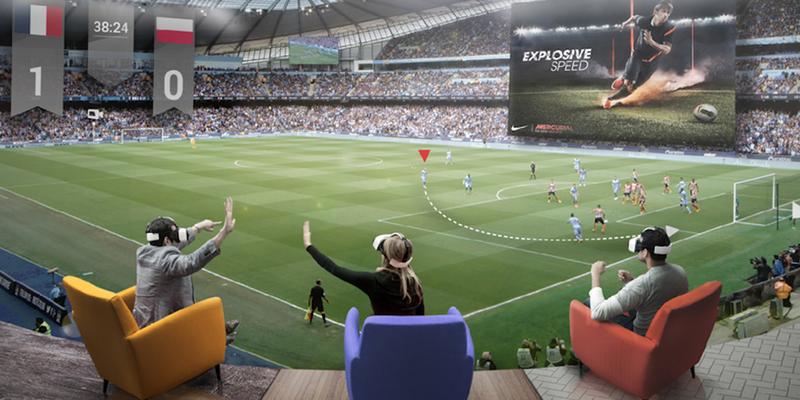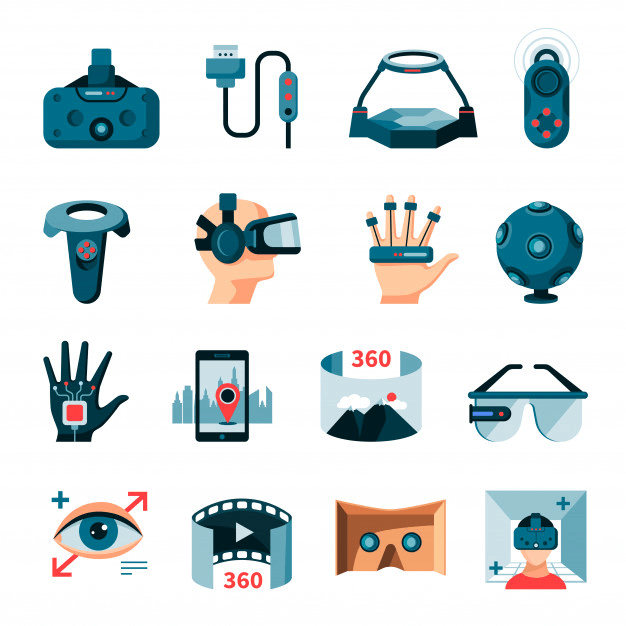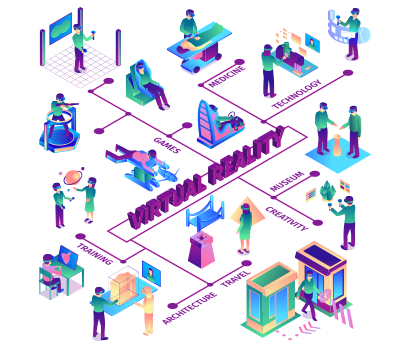When we talk about Virtual Reality, many of us think of science fiction movies. We all wonder what if we can create dream worlds like Nolan’s Inception or a sci-fi realm like Interstellar. What if this is all possible in today’s world, that you can create your own world and bring your imagination to life? Yes! Virtual Reality makes this possible.
Thanks to numerous techno-geek developers and VR development companies for their contribution to VR, it has become an everyday part of our life. It lets us watch, feel, hear, and even experience things that never really exist in reality.
“VR technology market size is forecast to reach $92.31 billion in 2027.”
Nowadays, multiple companies offer virtual reality app solutions. Are you planning to build a similar app? Before starting to create a VR app it is necessary to do thorough research. It is important to find out the dos and don’ts, choose the correct development platform, decide the budget, and then move forward with the development. We bring you a detailed guide on how to make a VR app from ground-zero. Tag along!
Herein we will discuss:
- Virtual Reality: Use-Cases
- VR in Apps and VR Equipment
- How to make a VR app
- Virtual Reality Apps: Challenges and Future Scope
- How to Make a VR App That Stands Out in the Market
- How Much Does it Cost to Make a VR App?
Virtual Reality: Use-Cases
VR apps make use of Virtual Reality, an immersive experience that digitally creates a virtual environment. A variety of domains use this concept viz. Education, architecture, digital marketing, engineering, robotics, arts, healthcare, heritage, archaeology, entertainment, science and psychology, and so on. Before we move forward, let us have a detailed look at VR apps and their use-cases.
1. Automotive Industry
Virtual reality lets designers and engineers experiment with various looks of automotive vehicles before creating expensive prototypes. Many companies like BMW, Jaguar, etc. use VR to run a design and engineering review on their prototypes.

(Source)
This helps them check the visual design and object obscuration. It helps in diagnosing the prototype before actually spending money on manufacturing parts. Virtual reality is saving the automotive industry millions of dollars by reducing the cost per vehicle prototype.
2. Healthcare

(Source)
Virtual reality has a significant impact on the healthcare sector. Virtual models replace real bodies so that medical examiners can conduct their practices. VR helps in pain relief for burn injuries. VR can also cure mental health issues. Virtual Reality Exposure therapy is effective in treating PTSD and anxiety.
3. Retail Industry

Ever wondered what if you could try the clothes and accessories that you purchase online. Not being able to do so results in us buying the wrong size, color and whatnot. With VR in online shopping, this scenario can change.
Multiple companies are working to bring this shopping experience to their customers. EBay in partnership with Myer, launched the world’s first VR retail shop.
4. Tourism and Navigation
What if you can visit your holiday destination before you buy those holiday packages. Virtual reality can make this possible. With VR you can go on guided virtual tours of hotels, restaurants, and tourist landmarks. Thomas Cook launched the ‘Try before you fly’ package in 2015 to let the users experience their holidays in VR before buying.

(Source – newsroom.cisco.com)
Google expeditions is another example of making tourism more accessible. It allows the users to explore coral reefs and even travel to Mars – all this from their home.
5. Real-Estate

(Source)
Using Virtual Reality, users can look round properties from the comfort of their home. This allows users to explore properties online and view their favorite ones in-person. Matterport is one such company to provide this experience to users.
6. Education and Learning
The Education Industry has always looked for ways to make knowledge accessible to everyone in a quick and simple manner. Therefore, many learning technologies aim at enabling this access to information and facts around the world to everyone.

Virtual Reality enables us to implement an immersive experience and improve learning. 53% of survey respondents plan to use VR in the near future. About 68% acknowledged that VR technology excites students to learn.
7. Sports Industry
Imagine practicing for an sport from anywhere, anytime, just as if you were on field, court, slopes, ice, or course. With VR in sports industry, accelerating the training regimen with immersive learning is possible.

(Source)
Using VR, viewers can watch the games and see what they want to. Decision makers of the game can recreate the entire scene and avoid ambiguity. Overall, it enhances the fans and athletes experience. STRIVR is a good example of VR in sports training.
Before you create a VR app, deciding the correct area of VR implementation is the important first step to take. The entire development process depends on the industry you choose to build your VR app for.
Wondering How to Make a VR App for Your Industry Specialization?
VR in Apps and VR Equipment
VR combines real-time simulations with graphics and then creates a fully immersive 3D experience. There are multiple VR devices available for different purposes. The most common of them is a head-mounted display headset (HDM headset).
These headset used along with controllers lets the user control the VR experience. In this, the user wears the device to view images, videos, and so on. They can interact with real-time objects and places using the controllers. It lets the users interact with a computer-generated world using gestures and motions. The software simulation records the motions and gestures made by the user in the real world.
Sensorama is one of the first VR devices built in the 1950s. It is a machine with a built-in seat that plays 3D videos and generated vibrations to make the experience as real as possible. Subsequent technological advancements over the following years brought a progressive evolution in the form of Virtual Reality app development.
With VR apps, we can create our own immersive worlds on the desktop itself. With smartphones, we can access it from anywhere and everywhere we want. In the next section, we will discuss the prospects, dos and don’ts, prerequisites, future, and so on for your VR app building. This will surely answer all your questions on how to make a VR app that gains lucrative results.
How to make a VR app
Creating a Virtual Reality app is a complex process that requires expertise in multiple technologies for commercial success. The key development principle to make a VR app is to develop them with a high-performance, low power-consuming architecture, and an errorless application code.
It also includes software and hardware design that involves the use of prototyping tools, development libraries, frameworks, and so on. Let’s have a detailed step-by-step look at how to make a VR app.
Step 1: Define Major Goals for the App
Before you research how to make a VR app, consider deciding the major goals for your app. This is the first most important step to create a virtual reality app. You need to define clear goals of what you want to achieve from the app. It can be a stand-alone experience, a gaming experience, a touring experience, and so on.
You must know precisely what you want to build, only then will you be able to answer questions like how to make a VR app and so on. Without clear parameters, you’ll never be able to create a precise experience with the app.

It is essential to think about what users will expect from the app and what you as an app publisher want them to experience. You need to think about the features that will give an immersive as well as compelling experience. You must also think about making your content accessible on the web and making it popular amongst VR enthusiasts through various social media channels.
Beyond reaching a new audience, you must think of building an interface that might help retain users and produce deeper engagements. You must also think about providing an in-depth guide using explainers, video tutorials, and so on.
Step:2 Define Compatibility
1) Virtual Reality for Smartphones
VR applications for smartphone devices have the potential that many techno-giants are still trying to live upto. Certain VR platforms like Google Daydream require launching into a separate app environment which may get inconvenient for users.
For example, removing Apple’s headset cord and blocking the phone from the screen actually enables iPhone VR apps. Besides, phone-based VR still has a number of other problems. After that only they can deliver equally intense physical experiences as desktop-based VR does.
2) Virtual Reality for computers
The VR apps designed for Windows, macOS, Linux etc. are the most compatible ones. Oculus Rift, HTC Vive, Playstation VR and so on are few of the most popular devices available nowadays to give you an immersive experience and make this VR exploration possible. Various purposes like gaming, educational reasons and so on can also use this experience.
Day by day VR is becoming popular and developers are thinking about how to adapt their designs to reach more audiences. While building VR games may still need particular expertise, developers are learning the exact design chops that they require for various gaming experiences.
Step 3: Select a Platform
The very first step to begin to create a Virtual Reality app is choosing an appropriate platform and a software development kit. The deployment platform selection is a crucial part of the app development process. The selection of app platforms directly impacts the app adoption rate which in turn has a huge and direct impact on the revenue.
Here are some important questions to ask while selecting an appropriate platform: Which device are you going to create a virtual reality app for? Do you want to create a VR app for mobile, or for a VR headset? If you want to make a VR app for mobile, will it be Android, iOS or both? Are you looking to make a VR app inside some VR providers like Oculus or will it be standalone?
You can use certain VR platforms like SteamVR, XboxVR and Oculus Home to support VR development. These provide a complete set of VR development tools. If you use them, you will not require any other software installation. Hence, starting with a brand specific SDK would be the perfect first step.
You also need to think about the launching platform for your app. Some of the most popular and widest reaching platforms are mobile VR headsets (Samsung Gear), new standalone, affordable options (Oculus Go) and so on. If your goal is to reach high-end game-playing audiences, you would need to start with Oculus Rift, HTC Vive etc. and prioritize platforms where you can find your biggest audience.
Step 4: Game Engines
Selecting appropriate game engines is yet another important step in the VR app development process. It stores the data that users are going to see in their virtual world. They render images and provide input methods to the user. Some popular examples of game engines are Nvidia’s Havok, Unreal Engine, Gear VR’s Unity3D, Unity Game Studio and so on.
Nowadays, most game engines are mostly available for free. Some gaming engines can be integrated with specific software development kits. Multiple APIs are used to customize these game engines.
Step 5: Frameworks and libraries
The next important step will be choosing the right frameworks and libraries. WebVR is a JavaScript that runs in the browser on the web and provides an API. This API in the VR applications makes it possible to experience VR in most of today’s browsers.
WebGL objects include graphics libraries. Its dynamics change with time and/or event handling, depending on your hardware devices. These libraries offer a real-time communication channel between application code and hardware to render graphics.
Step 6: Design and Prototype tools
The next step would be to make your VR app look good. For the designing of the VR app, the development team has to consider prototyping VR experience for testing and validation purposes.
Prototyping can help you test a 360-degree view which gives a sense of scale, use of sensors, viewing position of the user, and other attributes. Developers must be familiar with prototype creation using various software like Google blocks, Photoshop, and so on.
Step 7: Hardware

Knowing the kind of hardware that you will need to run your VR app is important. The most popular choices are HTC Vive and Oculus Rift VR headsets. It is preferable to choose an option which drives less power and has a more comfortable range of motion. Sensor systems by Rift and Vive have minimum hardware requirements. Besides, there are a number of VR device types, a few of which are mentioned below:
- Console
- Light mobile VR headsets
- Premium mobile VR headsets
- VR headsets connecting to external PCs
- Standalone headsets
- VR haptic feedback suits
Got A Unique Ideas for your VR app?
Step 8: How to Make a VR App that Sells
Considering the fact that most apps are free at the point of installation, the app business model needs adjustment to equalize this. Hence, app monetization is a necessary aspect. Monetization strategies require extensive marketing support before and after the launch of an app. But, deciding a strategy right at the beginning will help you plan out a roadmap on how to get the maximum benefit out of your health and fitness apps.
Some of the most popular monetization strategies for Virtual reality apps are:
1) In-app Advertising Model
The in-app advertising model is an effective one. The mechanism is quite simple. App developers serve advertisements within their mobile apps and in return they get paid for it. In VR apps this is one of the commonly used monetization models. These apps promote the ads generally at certain intervals.
2) Paid Model
The paid model users have to pay an upfront price before downloading. The user pays a fixed amount for the app regardless of the amount of utility they get. Most gaming VR apps use this model. They may also provide trial usage for a limited period of time to let the users get an idea about the app. This model fits an app with high brand recognition and outstanding reviews and ratings.
3) In-app purchases
The in-app purchase model is popular to generate humongous amounts of money by selling virtual products or physical goods from within the app. For these purchases there is a set commission paid by the app publishers to the app-store owners. Apple and Google both take 30% of every in-app purchase through any app.
4) Freemium Model
The freemium model allows users to utilize some basic features of the app for free and then charge for certain upgrades and access to special features. It is a well-known tactic adopted by companies to attract users to their services and generate revenue. With the premium model, users can keep using the app forever but to enjoy certain benefits and features they’ll have to pay. This helps them create a sustainable business rather than just a one-time hit.
5) Subscription
It overlaps with premium and freemium models. Subscription is a regular fixed fee paid by the user for using the apps. The subscription model provides a guarantee of repeat transactions. The cost of subscription is smaller compared to the one-time cost to incentivize the user into a long-term commitment. Businesses with subscription revenues tend to rank far higher in terms of revenue.
These were the five basic monetization strategies used in the VR app industry. To identify which model suits you the best, you have to focus on the purpose of the app and the type of users you are planning to serve. You can also check out which monetization model your competitors are following and the latest trends in in-app monetization. You can get a detailed insight of these monetization strategies here.
Virtual Reality Apps: Challenges and Future Scope
Virtual Reality is one with highest projected potential for growth. The VR market size is about to reach $92.31 billion in 2027, according to forecasts from grand view research. Another research from IDC says that investment in VR will multiply 21-fold over the next four years, reaching 15.5 billion Euros by 2022. In addition, VR will be key to the digital transformation of companies. Their spending in this area will exceed that of the consumer sector by 2021.

Nowadays, the market demands apps that are more affordable and unique. Virtual Reality still faces problems that are far from unsolvable. Firstly, it is not as practical as compared to other such concepts like augmented reality. Neither is it handy nor is it that flexible. And surely it is not economical. A study by Stanford states that people tend to get tired of wearing a VR headset in about eight minutes. So, one should keep these facts in mind before choosing the VR device and Integrating it with your app.
Another issue is the isolation issue. People get isolated when using VR devices and obviously their communication is very limited. Vocal interaction, if added to this, can prove a huge improvement too. Developers from companies like Oculus are working hard to find a way to incorporate vocal interactions and access to social media platforms and networks. This eliminates the social barrier and allows people to attend social or sport events together.
The distance limit would be gone and they can take part irrespective of wherever in the world they are or wherever in the world this event is taking place. Lastly, the video quality of 360 cameras is still not good enough and hence needs improvement.
Virtual reality is no longer science fiction. Various tech giants are already working to develop headsets that are cable-free. They are developing VR headsets with more powerful processors. Multiple companies have already made a benchmark with their VR apps. How will you make your app stand out in such a competitive environment? Here’s a trick.
How to Make a VR App That Stands Out in the Market
Many business entrepreneurs opt for a clone app, because of the common perception of clone apps being reliable and cost-effective. But there are certain drawbacks of the clone apps too. As cool as the app cloning approach sounds, it is not practical enough. After all, an original is worth more than a copy.
The overall quality and originality of mobile applications take a nosedive, because of clone apps. Many app publishers face problems like up-charging, bad UI/UX, less scalability, and poor functionality. Custom apps are an answer to the question of how to make a VR app that is unique. Hence, it is advisable to take the custom app route when you make a VR app. Here are a few benefits of custom apps in contrary to the drawbacks of clone apps:
Scalable: Custom can be personalized based on one’s business needs because they are built from scratch.
Functionality and Quality: Clone apps compromise the quality be it in terms of functionality or appearance. Custom apps have the potential to deliver qualitative results because your app development project is in the hand of a professional developer.
User experience: Users always look for something unique. Unique features intrigue user attention up to a larger extent. In custom apps, it is easy to introduce new and innovative features to solve this problem.
Advanced Features: With the app cloning approach, you have to go with the existing features that exist in the original app whether you want them in your app or not. Take the customer app approach to get rid of this extra baggage of unwanted features.
Cost: You may think that creating a clone app is cost-effective and affordable. The quality of apps is quite low in clone apps. Therefore, trying to salvage your app built with clone software may cost you even more than custom apps.
iOS App Store Law for Clone Apps: Apple introduced a set of rules for its App Store against clone apps. The apps built through app generation services, or by commercialized templates will be rejected from launching on its store. Custom apps have never faced such issues because they are original, and will never do!
So, these were the benefits of custom apps. Are you still hung up on the low-cost clone apps? Well, the difference between custom and clone apps is not much. Can’t believe it? Read ahead.
How Much Does it Cost to Make a VR App?
Biztech Consultancy assures you affordable pricing for the successful execution of your VR app idea. While calculating the actual cost to create a Virtual Reality app for Android or iOS, the platform (Android or iOS) plays an important role. It affects the total number of hours of our expert developers.
Create a VR App Development Roadmap.
VR app development is a tempting and lucrative idea. In order to implement correct development strategies for the profit of your company you first need to define your goals and needs and see which areas call for optimization. After defining the issues, you will be able to develop a suitable solution and then implement various monetization strategies to it.
The key to making a VR app that gives quality performance is the correct development process. Before you plan a roadmap to make a VR app you need to decide the correct monetization method and make the app UX smoother and bug-free. Make sure that you work with experienced developers who answer all your questions. Experienced developers can ensure successful implementation with wearable integration, monetization strategies, and also deliver a high-quality user experience.
Users’ perspective is important to maintain the overall experience. In short, it should have a personalized touch and it should also sell. Biztech Consultancy services are one such service that gives a personalized touch to all their products. If you still have doubts regarding how to make a VR app that best fits your business needs, we can help you create a perfect Virtual reality app. That is not all; we can also help you with the most relevant monetization strategies. We specialize in VR app development for both platforms: Android as well as iOS and also cross-platform apps.
Planning to create a VR app
